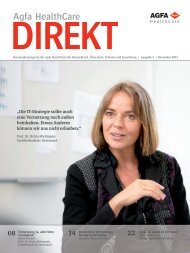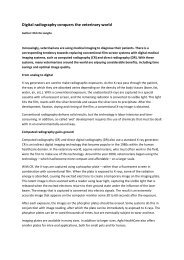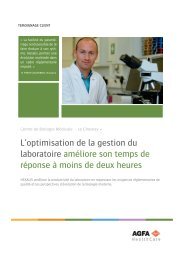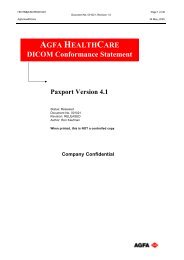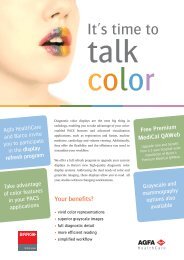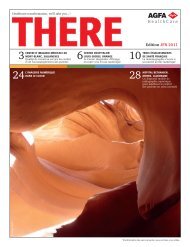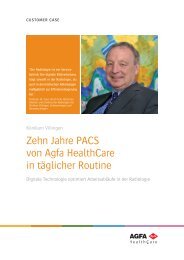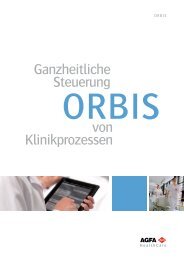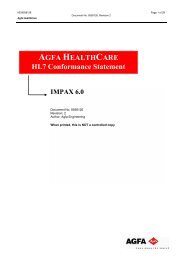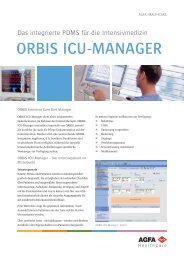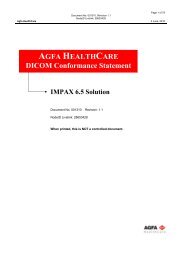Edition 4 - Agfa HealthCare
Edition 4 - Agfa HealthCare
Edition 4 - Agfa HealthCare
You also want an ePaper? Increase the reach of your titles
YUMPU automatically turns print PDFs into web optimized ePapers that Google loves.
locations. Patients can move around<br />
various campuses and still data<br />
is available at all times to all the<br />
doctors involved in their care. Data<br />
interpretation and second opinions<br />
are greatly enhanced and university<br />
hospitals can use this centralized<br />
information for teaching and research<br />
purposes.”<br />
“Another clear benefit of PACS is<br />
the ability to call up images, reports,<br />
diagnoses, both past and present,<br />
while we are actually with the patient.<br />
Cardiologists have a dual role to play<br />
– on the one hand the interpretation<br />
of the images and data, while at the<br />
same time ensuring we are providing<br />
treatment for the patient. Before PACS<br />
we would spend a significant amount<br />
of time sorting through paper files and<br />
reports and looking at images before we<br />
saw the patient. Today, this task can be<br />
performed in minutes, with the patient<br />
in the room – a huge time saving and a<br />
clear benefit to us all.”<br />
Where do you think current solutions<br />
will or can expand to<br />
“From my perspective, the ability to<br />
share data within and beyond hospital<br />
walls is where the future of PACS lies.<br />
This is something that radiologists have<br />
long understood the benefits of and<br />
have already accepted. Cardiologists still<br />
need to be convinced further. On the<br />
other hand if you look at the potential<br />
of data sharing for driving research,<br />
teaching and the ability to consult other<br />
specialists for interpretation of some<br />
challenging cases, there is a strong<br />
argument there that needs further<br />
promotion. As the amount of data we<br />
receive increases, PACS and CVIS will<br />
play an important role in enabling us to<br />
manage not only our workload, but to do<br />
so efficiently.”<br />
“Additionally, the future development<br />
of diagnostic and therapeutic care<br />
programs in Cardiology will heavily rely<br />
on the availability and interpretation of<br />
digital data, extracted from the PACS,<br />
CVIS and HIS (Hospital Information<br />
System).”<br />
Do you see diagnostic standardization<br />
as a key component to driving<br />
more acceptance of image and data<br />
management solutions in cardiology<br />
“Diagnostic standardization is key<br />
to driving efficient healthcare: I am<br />
convinced of this. However, before we<br />
can talk about standardization, we<br />
should first ensure that we have driven<br />
acceptance. At the University Hospital of<br />
Leuven we have reached a point where<br />
the different clinical specialties dealing<br />
with diagnostic imaging have achieved<br />
this level of acceptance, and are now<br />
moving towards this standardization.”<br />
As the amount of data we<br />
receive increases, PACS<br />
and CVIS will play an<br />
important role in enabling<br />
us to efficiently manage our<br />
workload.<br />
“Specifically in the framework of<br />
the multidisciplinary European Council<br />
on Cardiovascular Imaging, we have<br />
brought together all the different<br />
specialties dealing with diagnostic<br />
imaging and are currently developing<br />
an accepted workflow methodology<br />
to dealing with, in my specific case,<br />
cardiovascular diagnosis. Because<br />
two or more clinical specialties are<br />
involved (in imaging that would mostly<br />
mean radiology, nuclear medicine and<br />
cardiology), having concrete workflows<br />
and agreements on which modalities<br />
will be used for analysis, and under<br />
which circumstances, is an important<br />
step to improving overall efficiencies<br />
and results. The aim is relatively<br />
simple: to deliver an accepted patient<br />
‘pathway’ dependent on the diagnostic<br />
needs. We want to answer the specific<br />
clinical questions that drive the need<br />
of an investigation in the most efficient<br />
and simple way. That means that a<br />
single patient, with a specific medical<br />
condition, in combination with other<br />
factors such as age, gender, body<br />
mass, co-morbidities, and so on, will<br />
be identified and categorized before<br />
diagnostic screening. The result of this<br />
analysis will then concretely define<br />
which modalities will be required<br />
to achieve the best result, rather<br />
than subjecting a patient to different<br />
modalities which may, in the end, not<br />
provide relevant or sufficient data. The<br />
aim is to implement this standardized<br />
workflow as a standard practice for all<br />
cardiologists within the facility.”<br />
“The approach is, in its own<br />
right, quite simple but its eventual<br />
implementation will nevertheless be<br />
complex, given the many thousands<br />
of patients our facility treats annually.<br />
The path that a patient will follow and<br />
the modalities used to help us identify<br />
and diagnose their condition will be<br />
pre-defined in around 85% of all cases<br />
we see. In about 15% we will need<br />
to apply more complex paths, as the<br />
patient’s condition will not ‘fit’ within<br />
the standardization. But again certain<br />
standards will be applied here, be it more<br />
complex. Furthermore, the development<br />
and eventual implementation of such<br />
accepted ‘pathways’ will also play an<br />
important co-operative role. The fact<br />
that we have put all clinical specialties<br />
around one table to plan and develop<br />
such an approach has also drastically<br />
increased our levels of co-operation,<br />
delivering a combined level of expertise<br />
to the patient.”<br />
“Finally, the significance of this type<br />
of project should not be underestimated.<br />
If we do not drive efficiencies on a<br />
healthcare level, payers and government<br />
bodies will drive them for us. Today we<br />
are able to drive reimbursements for<br />
patients on as many examinations as<br />
we consider necessary to diagnose the<br />
patient, but as healthcare comes under<br />
increasing economic pressure, we will<br />
be put under stress to limit this. The<br />
technology to support this drive for<br />
improved efficiencies, such as PACS and<br />
CVIS, are already in place and clinical<br />
applications enable us to gather more<br />
qualitative and quantitative data from<br />
the images we receive. It is now up to<br />
us to drive our daily workflow to match<br />
these efficiencies more effectively.”<br />
Do you see Cardiology PACS and CVIS<br />
playing a bigger role in the larger<br />
hospital enterprise<br />
“They will have to, for all the<br />
reasons indicated above. Add to that<br />
the multiplication of data we manage<br />
today, driven by Echo, MRI, CT, and so<br />
on, and it makes the management of<br />
our daily work without a PACS and a<br />
CVIS unthinkable. Efficient patient care<br />
is also often driven by the expertise of<br />
different specialties, and is enabling<br />
us to have access to all clinical data<br />
through an integrated Hospital and<br />
Clinical Information System. This will<br />
only enhance our ability to deliver high<br />
quality treatment. I also see healthcare<br />
IT as a key enabler of the cooperation<br />
between the various clinical departments<br />
of the hospital enterprise. Data sharing is<br />
knowledge sharing, and few would argue<br />
that this is not a benefit for clinicians to<br />
diagnose disease better, and for hospitals<br />
to improve their cost efficiencies and<br />
overall patient care.” •<br />
THERE 21



